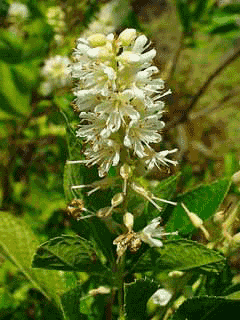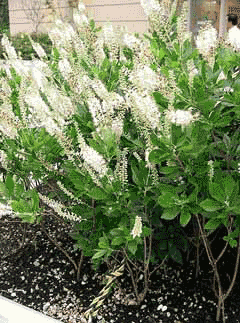 |
|
|
 |
| http://commons.wikimedia.org/wiki/User:KENPEI |
Translate this page:
Summary
Bloom Color: White.
Main Bloom Time: Early summer, Late summer, Mid summer. Form: Oval, Upright or erect.
Physical Characteristics

 Clethra alnifolia is a deciduous Shrub growing to 2.5 m (8ft) by 2.5 m (8ft).
Clethra alnifolia is a deciduous Shrub growing to 2.5 m (8ft) by 2.5 m (8ft).
See above for USDA hardiness. It is hardy to UK zone 3. It is in flower from August to September, and the seeds ripen in October. The species is hermaphrodite (has both male and female organs) and is pollinated by Bees.
It is noted for attracting wildlife.
Suitable for: light (sandy) and medium (loamy) soils and prefers well-drained soil. Suitable pH: mildly acid and neutral soils. It can grow in semi-shade (light woodland) or no shade. It prefers moist or wet soil.
UK Hardiness Map
US Hardiness Map
Synonyms
Plant Habitats
Woodland Garden Sunny Edge; Dappled Shade; Hedge; Bog Garden;
Edible Uses
References More on Edible Uses
Medicinal Uses
Plants For A Future can not take any responsibility for any adverse effects from the use of plants. Always seek advice from a professional before using a plant medicinally.
None known
References More on Medicinal Uses
The Bookshop: Edible Plant Books
Our Latest books on Perennial Plants For Food Forests and Permaculture Gardens in paperback or digital formats.

Edible Tropical Plants
Food Forest Plants for Hotter Conditions: 250+ Plants For Tropical Food Forests & Permaculture Gardens.
More

Edible Temperate Plants
Plants for Your Food Forest: 500 Plants for Temperate Food Forests & Permaculture Gardens.
More

More Books
PFAF have eight books available in paperback and digital formats. Browse the shop for more information.
Shop Now
Other Uses
References More on Other Uses
Cultivation details
Landscape Uses:Pest tolerant, Massing, Screen, Seashore, Specimen. Prefers a well-drained lime-free sandy and peaty soil[11, 182]. It loves abundant moisture at its roots[11]. Prefers a sunny position or partial shade[164]. Dormant plants are hardy to about -30°c[184, 200]. A good bee plant[106], the flowers are very aromatic[K]. There are some named varieties developed for their ornamental value. 'Paniculata' has longer-lasting branching panicles of flowers[182]. Like the species type, the flowers of this cultivar are very sweetly scented[245]. Suckers are freely produced when the plant is grown in conditions similar to its natural habitat[200], the plant forming thickets[182]. Plants in this genus are notably resistant to honey fungus[200]. Special Features:North American native, Wetlands plant, Attracts butterflies, Fragrant flowers, Attractive flowers or blooms.
References Carbon Farming Information and Carbon Sequestration Information
Temperature Converter
Type a value in the Celsius field to convert the value to Fahrenheit:
Fahrenheit:
The PFAF Bookshop
Plants For A Future have a number of books available in paperback and digital form. Book titles include Edible Plants, Edible Perennials, Edible Trees,Edible Shrubs, Woodland Gardening, and Temperate Food Forest Plants. Our new book is Food Forest Plants For Hotter Conditions (Tropical and Sub-Tropical).
Shop Now
Plant Propagation
Seed - sow early spring in a greenhouse[113]. Only just cover the seed and keep the pot moist. Germination usually takes place within 1 - 3 months at 13°c[164]. When large enough to handle, prick the seedlings out into individual pots and grow them on in the greenhouse for at least their first winter. Plant them out once they are more than 20cm tall in late spring or early summer after the last expected frosts. Cuttings of half-ripe wood, 7 - 10cm with a heel, July/August in a frame[11, 113]. Very easy[113]. Root cuttings in December/January[113]. Suckers in the dormant season[113]. They can be planted out direct into their permanent positions if required. Layering of current years growth in late autumn. Takes 18 months. Can also be done in early spring[200].
Other Names
If available other names are mentioned here
Native Range
NORTHERN AMERICA: United States (Connecticut, Maine, Massachusetts, New Hampshire (southeast), New Jersey, New York (southeast), Pennsylvania (east), Rhode Island, Alabama (south), Delaware, Florida, Georgia (south), Louisiana (south), Maryland, Mississippi (south), North Carolina (east), South Carolina, Virginia, Texas)
Weed Potential
Right plant wrong place. We are currently updating this section.
Please note that a plant may be invasive in one area but may not in your area so it's worth checking.
Conservation Status
IUCN Red List of Threatened Plants Status :

Growth: S = slow M = medium F = fast. Soil: L = light (sandy) M = medium H = heavy (clay). pH: A = acid N = neutral B = basic (alkaline). Shade: F = full shade S = semi-shade N = no shade. Moisture: D = dry M = Moist We = wet Wa = water.
Now available:
Food Forest Plants for Mediterranean Conditions
350+ Perennial Plants For Mediterranean and Drier Food Forests and Permaculture Gardens.
[Paperback and eBook]
This is the third in Plants For A Future's series of plant guides for food forests tailored to
specific climate zones. Following volumes on temperate and tropical ecosystems, this book focuses
on species suited to Mediterranean conditions—regions with hot, dry summers and cool, wet winters,
often facing the added challenge of climate change.
Read More
Expert comment
Author
L.
Botanical References
1143200
Links / References
For a list of references used on this page please go here
Readers comment
© 2010, Plants For A Future. Plants For A Future is a charitable company limited by guarantee, registered in England and Wales. Charity No. 1057719, Company No. 3204567.